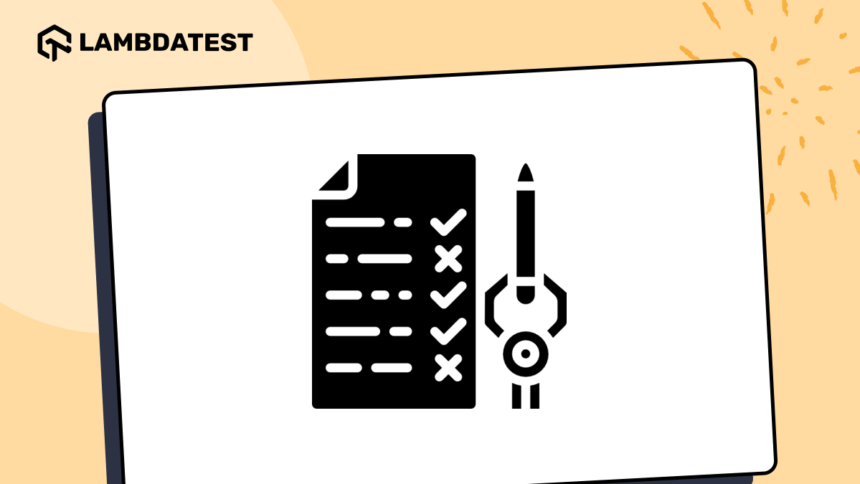Can you release software without implementing thorough testing? No? This is because the complexity of modern apps requires robust testing strategies so that the apps can adapt to various dynamic user environments. To design these test scenarios, you can use various popular cloud-based cross-browser testing platforms like LambdaTest.
Platforms like LambdaTest allow you to create, execute, and manage multiple test scenarios and also customize them as per the changing requirements of an application. New to LambdaTest? Do not worry! Our article is here for you.
Here, we will help you understand the practical aspects of creating effective testing scenarios with LambdaTests while covering various important features, best practices, and actionable insights.
Why LambdaTest
Now you might come up with the question that although there are multiple cloud-based platforms available in the market, “Why did we choose LambdaTest?” To answer this question, let us begin with the basic knowledge of LambdaTest.
LambdaTest, an AI-powered test orchestration and execution platform, lets you perform manual and automation testing at scale with over 3000 real devices, browsers, and OS combinations. This online device farm helps you to eliminate the need of maintaining an extensive local infrastructure and also allows you to focus on the testing details and quality assurance practices.
To further justify our choice of LambdaTest, let us go through some of the major features of this platform that will highly elevate the quality and efficiency of your testing infrastructure:
- With LambdaTest, you can implement automated cross-browser testing by testing an application on more than 3000 different browsers and operating system combinations. The most effective advantage is that you can also access various legacy browser versions that are no longer available in the market to improve the compatibility of your app.
- LambdaTest also allows you to perform real device testing with this device farm. This is a very important parameter to verify that your application is functioning properly when subjected to various physical parameters of a device.
- LambdaTest can help you automate the testing scenarios by integrating various frameworks like Selenium, Cypress, and Playwright. With these frameworks, you can write the automation test scripts in any of your preferred programming languages.
- This platform also allows you to compare screenshots with existing benchmark data to identify visual differences across multiple browsers. This is a very important parameter to implement smart visual regressions in your application testing cycle.
- The testers can easily integrate LambdaTest with continuous integration and continuous deployment pipelines for improved testing efficiency and also to execute the testing and development phases at the same time.
- After executing the test cases, LambdaTest will automatically capture logs, network data, and console logs to pinpoint the issues and also assist you in the resolution steps.
- Finally, LambdaTest also helps implement geolocation testing so that you can ensure that your application performs across multiple geographic locations irrespective of various topographical barriers.
With the above features, LambdaTest will empower the testing teams to streamline the entire testing workflow while improving the overall quality of the application that is currently being developed.
Why Test Scenarios Are Important
Test scenarios are very important as they will help you to define the scope and objectives of your testing activities. These scenarios will also provide a high-level description of what needs to be tested while ensuring optimal coverage of all the critical functionalities of your application.
To help you understand all the factors important for creating well-crafted test scenarios, we have mentioned some of the most important components of it below:
- It is very important to identify potential user workflows and interaction patterns.
- This scenario must help reduce the ambiguities within the test cases.
- It must provide an alignment with business requirements and the technical expertise of your application.
- Finally, the test scenario must have a role in improving the collaboration among the stakeholders of the company.
Steps to Create Effective Test Scenarios with LambdaTest
To create effective test scenarios with LambdaTest, you need to follow a series of steps and strategies. To simplify this knowledge for the new testers, we have mentioned all the important factors that you must keep in mind during this process:
1. Understand Application Requirements
The first step of this process should be to understand the application’s requirements thoroughly. To further help improve the understanding process, you can consider collaborating with product owners, developers, and other stakeholders. These people can provide unique insights regarding the core functionalities of the target user demographics, performance expectations, and browser capability requirements.
2. Define Testing Objectives
Now that you have developed a clear understanding about the expected application requirements, you can move on towards defining the testing objectives based on these requirements. These objectives must be clear and can include:
- Validating the major features of the application across multiple browsers and browser versions.
- Ensuring that the application’s visual elements are consistent across different screen resolutions and are also interactable at the same time.
- Testing the performance of the application and also its stability under high load conditions.
3. Select Target Browsers and Devices
As we already mentioned earlier, LambdaTest provides a huge list of available browsers and devices to execute the testing processes. While choosing your targeted browsers and devices from this massive list, you can consider the following parameters:
- You must primarily target those browsers and devices that have the largest market share among your target audience.
- It is also important to have a clear focus on the audience demographics of the application that is being developed.
- Finally, you must focus on the specific client requirements and preferences during this step.
4. Write High-Level Test Scenarios
Now that you have finished all the basic steps regarding the test setup and browser selection, you can develop a high-level test scenario which will capture the major workflows and functionalities of the application. These test scenarios might include the following:
- Verifying the user login functionalities on browsers like Chrome and Firefox.
- Checking the product filtering options on mobile devices and ensuring that they are properly functional.
- The payment gateway integration works on different operating systems and there isn’t any payment failure while checkout.
5. Use LambdaTest’s Features to Enhance Scenarios
LambdaTest natively comes with various features that further help you improve the test coverage and efficiency while implementing cross-browser testing:
- You can use the live testing feature to manually verify test scenarios in real-time across multiple browsers at the same time.
- The automation testing feature helps you create automated test scripts using various frameworks like Selenium or Cypress to run the test scenarios with minimal human involvement.
- You can use the visual regression testing feature to capture screenshots for visual comparison and ensure the proper placement of all the UI elements.
- Finally, geolocation testing helps simulate various user environments from various geographic locations for improved testing efficiency.
6. Automate Test Scenarios
By using automation, you can accelerate the testing process and ensure consistency at the same time. LambdaTest’s integration with frameworks like Playwright and Cypress helps automate the repetitive test scenarios. For example you can automate login workflows and data-driven testing. You can also schedule recurring tests using LambdaTest’s automation scheduler.
To further help you understand running automated cross-browser testing with LambdaTest, we have mentioned a sample code snippet with Selenium and Python.

7. Integrate with CI/CD Pipelines
The testers should integrate LambdaTest with continuous integration and continuous deployment pipelines to enable continuous testing. During this step, you can also use tools like Jenkins, Circle CI, or GitLab CI/CD. These integrations will run automated tests after every build and also receive immediate feedback on the application quality.
8. Analyze Test Results
Finally, you must analyze the comprehensive test reports that will be automatically generated by LambdaTest. These reports will include logs, screenshots, and network activity reports. These insights will help you identify and fix issues properly, validate the test coverage, and also share results with the relevant stakeholders in your company.
Best Practices for Effective Test Scenarios
Finally, let us go through some of the best practices that can help you improve the effectiveness of your test scenarios while elevating the quality of the application along the way:
- You must prioritize the scenarios based on risk. This means that you must focus on high-impact areas like critical user workflows, features prone to defects, and modules with high usage rates. This practice will help you ensure that at least the basic and critical architecture of the application is functional at all instances.
- We suggest the testers to simulate real-user behaviors to uncover potential issues within the application infrastructure. For example, you must test on slow networks using LambdaTest’s network throttling feature. You should also focus on implementing accessibility compliance using screen readers.
- LambdaTest’s parallel testing feature will be highly beneficial when you’re working on complex applications consisting of thousands of different elements. This is because it will help you run multiple tests simultaneously to reduce the execution time and also accelerate the feedback loop. The proper implementation of this step will help you wrap up the entire testing scenario within just a few days.
- It is very important for the testers to maintain a repository of reusable test scenarios as it will help them to save time and also ensure testing consistency. During this process, you must organize the scenarios based on functionality, browser, or device configuration.
- Finally, we suggest the testers to use LambdaTest’s integration with tools like Slack, Jira, and Trello. These integrations will help you to share test results, report issues, and also collaborate with the respective team members of your company. Practices like these are massively useful in reducing the feedback time and rolling out the application in a short time.
The Bottom Line
Based on all the factors that we have analyzed in this article, we can safely say that creating effective test scenarios is very important to deliver high-quality applications. To achieve this goal, LambdaTest will provide a robust platform that streamlines the testing process, offers features like cross-browser testing, and also visual regression practices.
By following all the steps and best practices that we have mentioned in this article, you can enhance your test coverage while accelerating the feedback loop and ensuring a seamless user experience.
So, whether you are a quality assurance professional or a developer, you must grasp the capabilities of LambdaTest to empower your teams for creating efficient, scalable, and effective testing scenarios.
For More Inforamtion Visit Timelymagazine








